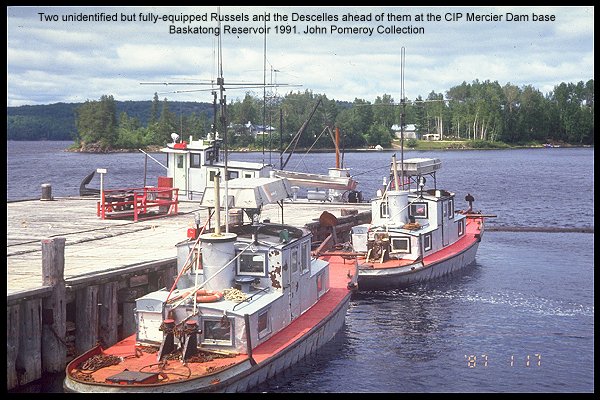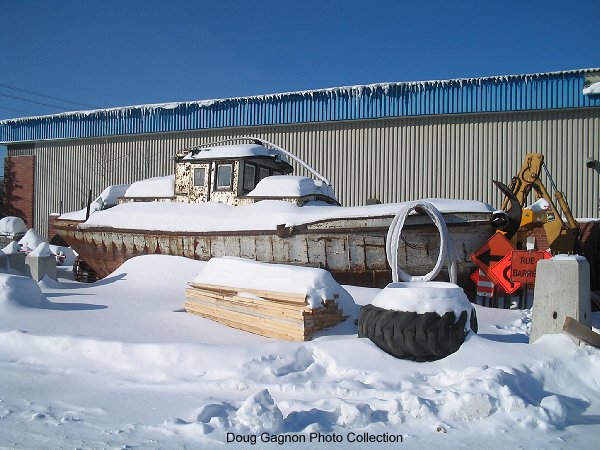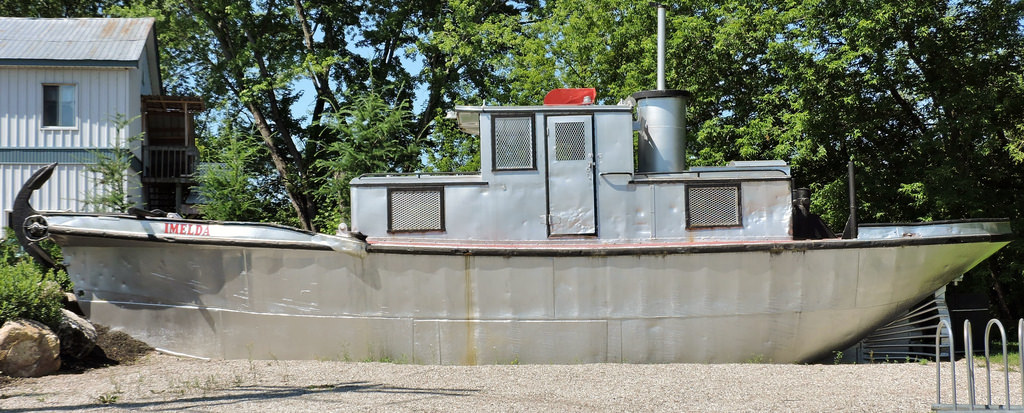Russel Brothers Limited OWEN SOUND, ONTARIO Steelcraft Boat Builders
| Imelda M.
Canadian List of Shipping 1956: Imelda M. [C.190542] registered at Ottawa; built at Owen Sound in 1949. 37' 9 x 10' 5 x 4' 7; 13 g.t.; 9 n.t.; 125 hp. Owned by The Canadian International Paper Co., Ltd., Montreal. Canadian List of Shipping 1970: Steel tug Imelda M. [C.190542] registered at Ottawa. Built at Owen Sound in 1949. 38'; 13 g.t.; 9 r.t. Owned by Avenor Inc., 1250 Rene Levesque Blvd., West Montreal, QC H3B 4Y3. Canadian List of Shipping 1997: Steel tug/other lmelda M. [C.190542] registered at Ottawa. Built at Owen Sound in 1949. Dimensions: 11 meters; 13 g.t. Owned by Avenor Inc., 1250 Rene Levesque Blvd., West Montreal, QC H3B 4Y3. Transport Canada List 2003: Owned by ville De Maniwaki, Maniwaki, Qu�bec. |
Lacroix Dam, Baskatong resevoir in September 1979, Basko (trimmed in red), Imelda M. is tied beside Basko, Decelles is tied at the end of the pier. W.J. Williamson (the biggest thing ever on the Gatineau River) is on the other side of the dock. (Not a Russel...) Photo courtesy Doug Gagnon.
John Pomeroy notes: Baskatong Reservoir, 1987. Doug Gagnon notes (Jan. 2008): Decelles at Lacroix Depot at Baskatong, with two fully equipped Russel's . The first one (closest to Decelles.....bow at Decelles stern) is the Imelda M. the other one is the T.F. Whalen. Sad to say, T.F. Whalen was scrapped in the early 90's. Dan Stosic of Maniwaki had bought a bunch of Russel's when the drive stopped. He bought Basko ( donated to Municipality of Montcerf/Lytton) T.F Whalen, Bertrand, Fautina and Gyp. T.F. Whalen's engine was shot and because of this, couldn't find a buyer, she sat in his mahine yard for a couple of years and was finally cut up and sold for scrap. So, in that pic of John's, from the top down, you've got Decelles, Imelda M, and T.F Whalen. 
|
Imelda M. in the Baskatong.
 |
More photos from the Baskatong.
John Pomeroy comments (Mar. 2018): "In the center photo, the two big ones are the Williamson and the Pythoga. And the winch boat with the grey (as opposed to red) deck is likely the Basko. The Williamson is still afloat on the Baskatong. What a beauty! Neither she nor the Pythonga are Russels, though." Source: Slideshow: Days of the Lumberjacks Baskatong Reservoir
http://www.ci-chateaulogue.qc.ca/en/pythonga.shtml
|
The Ottawa Citizen
Ottawa, Ontario, Canada
Mon, 15 Nov 1993, Page 11
Logging boat on the beach. Surplus vessel to be cut up after its sale
By Sean Upton Citizen Outaouais bureau. MEMORIES: Rheal Lafontaine stands aboard the Williamson with smaller logging vessels in the background
The W. J. Williamson, the biggest logging boat to ever sail a river or lake in the Outaouais, will leave the Baskatong Reservoir the way it got here: in pieces. It's too heavy to load on a trailer in one piece and, even if it wasn't, it would be too tall to slip under the hydro lines that cross the highways going north and south. After 49 years on the Baskatong, a man-made lake 50 kilometres north of Maniwaki, Canadian Pacific Forest Products is selling the Williamson along with the smaller logging boats that drove the logs down the Gatineau River to the paper plant in Gatineau.
The log drive stopped in 1991 but the firm has been using some of the boats to clear the river of logs that slipped out of booms and created jams in the river's bays, says spokesman Andre Trudel. The cleanup is almost over and CP wants to sell the nine boats that are left from a fleet that once totalled more than 30, says Trudel.
The Williamson is double the size of most of the other boats to be sold. It is 24.4 metres long, and six metres wide, three storeys high, and made of steel. Its diesel V 12 motor produces 600 horsepower. Its size and weight make it impossible to move in one piece. It will have to be cut with torches before it goes anywhere, says Trudel. "I wouldn't go to watch that," says Rheal Lafontaine, the man who was the Williamson's captain for the last 27 years of duty. "It's the end of an era it's a shame."
He lived on the boat more than he lived with his family in Maniwaki during those 27 years. When he first took the wheel, he and his crew of six lived on the Williamson for four weeks at a time. After they were unionized, they got to go home every weekend. As much as he loves his family, he loved every minute of his life on that boat, Lafontaine says. And he would be happy to take the wheel again now, at 67. "I loved my work a lot. I would have liked to continue ... for a couple of years," he says.
Before becoming captain of the Williamson, Lafontaine handled smaller boats, including the Pythonga, the second largest of the fleet, skippered for most of the last 20 years by his brother, Armand. In all, Lafontaine spent 47 seasons (April to November) on the log drive. He started as a draveur, one of the men who walked on the logs to pry and push them on their way. After two seasons he got a job as a deck hand on a small boat and worked his way up to the helm of the Williamson.
The tug came from Halifax in 1943, where it had served as a harbor tugboat, and was named for William Joseph Williamson, a manager for CP. To make it to the Baskatong, it was cut in three pieces, loaded on a train, then re-welded at the lake. The Baskatong, the largest body of water in the Outaouais, was created by damming the Gatineau, and Gens-de-Terre rivers and smaller rivers and streams.
The Williamson hauled booms of logs from the mouths of the rivers across the lake to the Mercier Dam log-slide that spilled them in to the Gatineau River. It could pull three booms of logs, about 3,500 cords. But for all its horsepower, the Williamson had an average speed of one mile an hour when it was pulling booms. (Faster if there was a tailwind, slower in a headwind.) The Williamson probably won't pull wood ever again. Like the Gatineau paper plant, most mills get their wood by truck; log drives are no longer practical, says Trudel.
CP is hoping to find a buyer and Trudel estimates the boat is worth between $50,000 and $100,000. It might be worth that if it was on another body of water, says Charles Bond, owner of Bond Marine Contracting. He's bought seven of the steel 12-metre logging boats since CP started selling them. They can be moved in one piece. Bond uses them for work on the Ottawa, Rideau and St. Lawrence rivers.
"It's worth zip. It's worth a buck as it sits," he says of the Williamson. "It's going to cost (too) much to take it out." There are skeptics, but CP hopes to sell it to someone who will use it. Marcel Guilbeault, the caretaker at the Lacroix Dam where the Williamson is in dry dock, recently gave it a new coat of silver paint. It was used once this summer when a movie company used it for a period, made-for-television film, be Chant de la Silouette. The movie company had added its own paint job to make it look old and ratty.
Before it is shown on television, the movie will be shown at a theatre in Maniwaki in March. In the audience will be Lafontaine, watching what he thinks was the last-ever voyage of the Williamson. There is no doubt it was its last voyage on the Baskatong.
|
Photographed by Doug Gagnon Jan. 27th, 2006, Maniwaki, QC.
|
Date unknown, Maniwaki, QC.
|
Le bateau de drave Imelda.
L�Imelda arrive au R�servoir Baskatong en provenance du R�servoir Cabonga au d�but des ann�es cinquante. Il a �uvr� sur les eaux du Baskatong jusqu�� la ?n de 1992.
Il tient son nom de l��pouse de Monsieur Ermen�gilde Merleau, qui �tait assistant g�rant de la C.I.P. Inc. � l��poque.
Le travail du Imelda consistait en la formation des �lots de bois au moyen d�estacades, en vue de la grande travers�e du Baskatong. Dans le langage des draveurs on appelait cette op�ration le �booming�.
Ce travail necessitait de trois � quatre remorqueurs, le Whalen, le Simone, le Patsy Jo et le Basko accompagnaient le Imelda dans son travail. Chaque �lot de bois pouvait contenir jusqu�� 1000 cordes (3000 m ) de bois. Les essences �taient le cypr�s, le sapin, l��pinette et le pin. Les draveurs pr�paraient de trois � quatre �lots que le Remorqueur Pythonga touait jusqu�au Barrage Mercier.
L��quipage �tait compos� de trois hommes; un capitaine et deux hommes de pont (deckhand), des hommes tous tr�s t�m�raires, dont plusieurs ne savaient pas nager.
Avant les ann�es soixante, les remorqueurs n��taient pas �quip�s de v�tements de flottaison individuels. Les syst�mes de communication par radio font eux aussi leur apparition au d�but des ann�es soixante.
Les Lafrance, St-Amour, Lafontaine, Guibault, Lacoursi�re, Riel, Lacroix, Begley, pour ne nommer qu�eux, sont tous des gens qui ont �uvr� sur ce type de remorqueur. Les �quipages prenaient le large pour des p�riodes de six ou sept jours.
Le bois flott� sur le r�servoir Baskatong provenait des chantiers du nord de la Gatineau. Ainsi, le bois achemin� par la rivi�re Gens de Terre arrivait des chantiers du secteur Cabonga et des camps Pensive et Landron. Le bois de la Gappe de l�Esturgeon provenait de Parent et de Clova. Le bois qui arrivait par le lac Piscatonsin provenait des chantiers du d�p�t du lac d�Argent.
Mis � jour : 16 mai 2018
Imelda arrived at the Baskatong Reservoir from the Cabonga Reservoir in the early 1950s. It worked on the waters of Baskatong until the end of 1992.
It takes its name from the wife of Mr. Ermenegilde Merleau, who was assistant manager of CIP Inc. at the time.
Imelda M. towed log booms across the still water of the Baskatong.
This work required from three to four tugs, the Whalen, the Simone, the Patsy Jo and the Basko accompanied the Imelda in the work. Each boom could hold up to 1000 ropes (3000 m) of wood. The species were cypress, fir, spruce and pine. The loggers were preparing from three to four islets that the Tugboat Pythonga reached to the Mercier Dam.
The crew consisted of three men; a captain and two deckhands, men all very daring, many of whom could not swim.
Before the 1960s, tugs were not equipped with personal flotation devices. Radio communication systems also appeared in the early 1960s.
Lafrance, St-Amour, Lafontaine, Guibault, Lacoursiere, Riel, Lacroix, Begley, to name but a few, are all people who have worked on this type of tug. The crews were taking off for periods of six or seven days.
Driftwood on the Baskatong Reservoir came from shipyards in northern Gatineau. For example, timber from the Gens de Terre River came from the Cabonga and Pensive and Landron camps. The wood of the Sturgeon Gappe came from Parent and Clova. The wood coming from Lake Piscatonsin came from the yards of the Lac Argent depository.
https://www.ville.maniwaki.qc.ca/index.php/le-bateau-de-drave-imelda
Les bateaux Imelda & Gyp et son petit parc am�nag� � l'intersection des rues Roy et des Oblats.
For more Russel exhibits visit Owen Sound Marine & Rail Museum 1165 1st Ave West, Owen Sound, ON N4K 4K8
(519) 371-3333  http://marinerail.com http://marinerail.com |
|
|
|
|
|